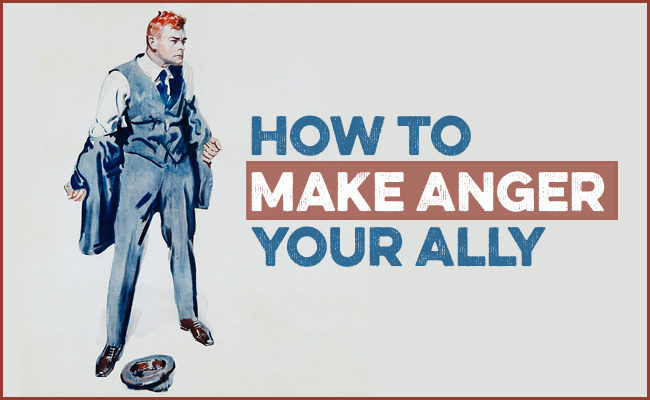
Most of us grow up thinking of anger as a problem. We’re told it’s childish, irrational, and something to repress or rise above. As journalist Sam Parker, author of Good Anger: How Rethinking Rage Can Change Our Lives, told me on the podcast, that assumption has left a lot of people more anxious and depressed than they need to be.
The reality of anger is more complicated. Anger is, in fact, a neutral emotion. Yes, it can make you snap at your kids or rage at a reckless driver. But it can also be a beneficial energy that helps you defend your boundaries, clarify your needs, and move forward on your goals.
The key is to learn how to work with anger, rather than against it — to make it your ally. The next time you feel your face get flushed and your pulse start to rise, here are four steps Parker suggested on the show to turn that heat into a positive force:
1. Name It
The first step is to simply recognize that you’re angry. For years, since Parker thought anger was a bad thing, he didn’t acknowledge that it was something that was present in his life. Then one day, while pounding a heavy bag:
I felt this strange surge of energy kind of coming up from somewhere lower down in my body, and I just started punching and swinging away with this kind of energy that I’d never had before, but also this feeling that I’d never had before in my body. And this went on for however long I managed to box for. And afterwards I was kind of sweating and bent over, exhausted. But I felt better than I had in months.
And I realized that the feeling that I tapped into was anger. I was absolutely furious.
And I was thinking about the things in my life that were going wrong and the conversations I needed to have to put them right. And everything was kind of unfurling beautifully in my thoughts. Everything was looking like targets rather than things to be afraid of.
Parker’s realization that he was deeply angry dramatically changed his life. By giving something he had been feeling all along a name, he was able to begin to get a handle on it.
We’ve talked before about the power of labeling emotions. Naming your emotions doesn’t make them disappear, but it does give you a better grip on them. There’s nothing quite so disempowering as knowing there’s an influence working on your thoughts and behaviors, but not being able to register and recognize what it is. Labeling your emotions allows you to evaluate them from an objective distance and gain greater control over what often feels like an uncontrollable force. Once you know, “I feel angry,” you can decide what to do about that.
2. Figure Out What the Anger Is Telling You
Anger is a signal. It imparts information. Psychologists say it usually points to:
- A boundary being crossed
- An unmet need making itself known
- An old wound being prodded
When anger shows up, ask: What does this say about the state of my life? What does this say about me? What does it say about my relationships?
Parker gave the example of feeling slighted at work. Maybe the jab was small, but your reaction feels out of proportion. Instead of brushing it off or blowing up, stop and ask: Why am I feeling so angry? Did that comment feel unfair? Am I feeling overlooked? Is this touching on some longstanding insecurity from my childhood? Once you figure out what anger is trying to tell you, you can figure out how to address its root cause.
3. Give Yourself 20 Minutes to Cool Off
When anger hits, your brain gets scrambled. Parker describes it like this:
You become momentarily disoriented. You can struggle to articulate yourself. You can struggle to understand your own thoughts . . . It’s a sort of mental scrambling.
You don’t want to react when your brain is addled by a surge of anger; you can end up saying or doing the wrong thing and hurting others or your reputation. It’s best to cool off a little before putting the energy of anger to use.
You may have heard that you should count to ten when you’re angry, but the research says it takes a lot longer for your system to reset — about 20 minutes. During that time, rehearsing arguments or plotting payback can just amplify your anger in an unhealthy way. Instead, use the break to distract yourself; Parker recommends listening to a podcast or reading a book. Taking a walk very often helps too — solvitur ambulando!
Parker says that while it is helpful to let your anger diminish a little before you react, you actually don’t want to let it cool down completely; as we’ll talk about next, anger can be a positive source of motivation, and you want to use it to take action while it’s still providing you a little heat.
4. Channel the Energy Into Something Useful
Parker calls anger the most energizing emotion. Once you’ve got it harnessed by labeling it, recognizing what it’s telling you, and letting its most volatile edge pass, you can channel anger’s energy into a productive force.
You might think that anger is like steam in a kettle that simply needs straightforward release. But punching or breaking things, yelling, or kicking over a wastebasket aren’t effective ways to deal with anger; venting without purpose usually just amplifies your rumination, which makes you more angry. Rather than releasing your anger in cathartic bursts, you want to direct it toward more sustained and constructive outlets.
If you’ve identified an interpersonal issue or boundary violation as the cause of your ire, use your anger to give you the boldness to have a difficult conversation with someone. While your anger can provide the push to initiate a forthright discussion, keep the dialogue itself calm and composed.
Even if an anger-causing issue isn’t within your power to resolve, you can still use your anger as a source of general energy; unleashing it during a workout can give you the drive to push yourself harder.
Parker notes that anger can also be used as a spur for tackling creative projects and reaching your goals. He calls it the “I’ll show you” energy. While seeking “revenge” for slights and offenses can sometimes be pursued in an unhealthy way, burning to prove the naysayers and critics wrong can be a very motivating and positive fuel for achievement.
Anger isn’t a bad thing or a good thing; it’s a neutral emotion that can be used for positive or negative ends. Aristotle had it right: the goal in life isn’t to banish anger but to purposefully direct it — “to be angry with the right person, to the right degree, at the right time, for the right reason, and in the right way.”
Do that, and anger isn’t dangerous — it’s a force for courage, growth, and greatness.
For more insights on anger, listen to this AoM podcast episode with Sam Parker:







